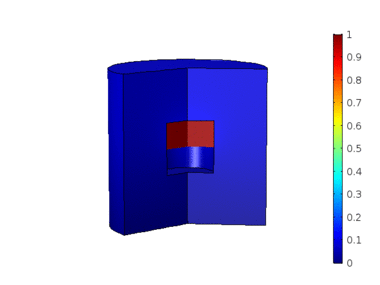The degree of debinding can be measured with very high reproducibility measuring weight of the samples. Reproducibility is 0.1% [1]. This allows for the creation of a meaningful database for calculating debinding kinetics. Several debinding runs with different temperature-time cycles are carried out on the same green samples at the HTL, and a robust numerical method is used to calculate a kinetic model from the measurement data. This enables prediction of the degree of debinding for any temperature-time cycle falling within the measured range [2]. Simple optimizations of the debinding cycle can already be achieved using this kinetic model. For example, temperature-time cycles can be calculated at which the debinding rate is nearly constant, resulting in lower stresses on the components than constant heating rate temperature-time cycles [3]. The maximum safe debinding rate is then experimentally determined using appropriately calculated temperature-time cycles, with debinding carried out on larger samples or small components in the TOM systems and any sample damage occurring during debinding being registered in situ. Sound or gas emission measurements are primarily used at the HTL to register damage since they can detect even slight damage.
For more detailed investigations, such as scaling up to other component geometries and considering effects in the industrial furnace, further in-situ measurements are necessary. The endo- and exothermic effects during pyrolysis and binder burnout must be quantified, which is done at the HTL by means of dynamic scanning calorimetry (DSC) in a controlled atmosphere. The thermal conductivity of the green parts is determined during debinding by means of laser flash method. In addition, the permeability of gases through the pore channels of the green body is measured. Together with the kinetics model, these measurement data are used in a coupled finite element (FE) model, which has been developed at the HTL for the optimization of debinding processes. With the model, the temperature distribution in the green body during debinding is calculated for each time step, taking into account the heat of reaction. The local debinding rate is calculated from the local temperature and the locally available oxygen with the kinetics model. The resulting gas-phase reactions lead to concentration and pressure gradients, which are reduced by diffusion and flow processes in the pore channels. These processes are also simulated by means of FE. Finally, for each time step, the mechanical stresses resulting from temperature differences and gas overpressure are calculated. The simulation is then repeated for the next time step until debinding is completed. The debinding conditions are varied with the FE model so that the mechanical stresses in the green body are minimized. In this way, debinding conditions can be targetedly optimized for individual components. Debinding cycles can be drastically shortened compared to empirically optimized cycles.
[1] Raether, F. (ed.): Energieeffizienz bei der Keramikherstellung, ISBN 978-3-8163-0644-3, VDMA-Verlag, Frankfurt, 2013.
[2] Raether, F.: The kinetic field - a versatile tool for prediction and analysis of heating processes, High Temperatures-High Pressures, 42.4, 2013, pp. 303-319.
[3] Raether, F.; Klimera, A., Herrmann, M., Clasen, R. (eds.): Methods of measurement and strategies for binder removal in ceramics. Special edition of Ceramic Forum international: Thermal process engineering in the ceramics industry, Göller Verlag, Baden Baden, 2008, pp. 5-11.
 Fraunhofer ISC, Center for High Temperature Materials and Design HTL, Bayreuth
Fraunhofer ISC, Center for High Temperature Materials and Design HTL, Bayreuth
